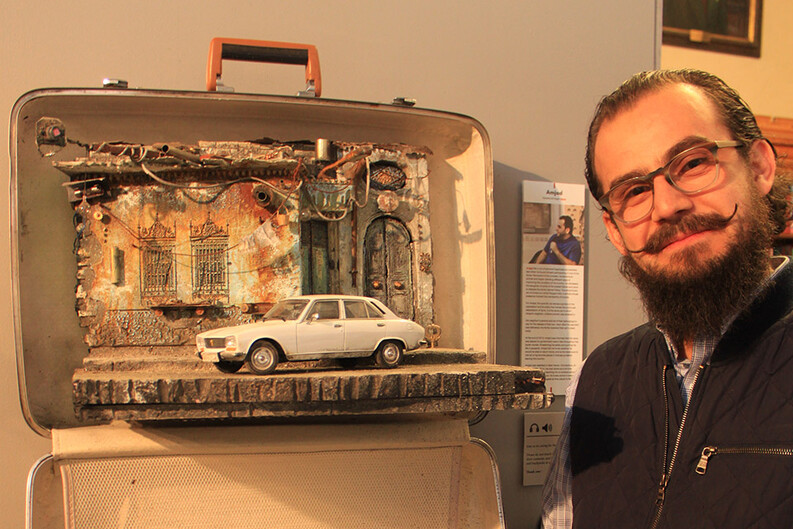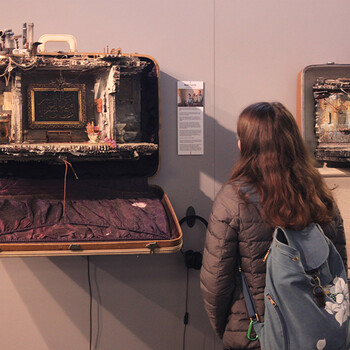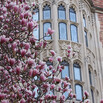Unpacking “UNPACKED” with Mohamed Hafez

UNPACKED: Refugee Baggage is a multimedia art installation created by Syrian-born, New Haven, Connecticut artist and architect Mohamad Hafez and Iraqi-born writer and speaker Ahmed Badr. Located in the Lillian Goldman Law Library Reference Room through April 5, 2019 and shown in conjunction with the Twenty-First Annual Bernstein Human Rights Symposium, Borders, Refuge and Rights, UNPACKED features Hafez’s sculptural recreations of spaces that have been damaged by war, which he situates inside suitcases. Each work is accompanied by audio of Badr’s interviews with the refugees whose memories inspired the scene inside each suitcase. In this interview with the Schell Center, Hafez describes his motivations for creating the installation and what he hopes viewers will take away from it.
Q: What can you tell us about “UNPACKED”? What kinds of themes are you exploring, and what are your goals with the work?
MH: UNPACKED is a multimedia exhibit that focuses on humanizing refugees in this very global refugee crisis. I collaborated with Ahmed Badr who attends Wesleyan University and who is himself an Iraqi refugee and a storyteller. Together, we interviewed refugee families in the New England area from all over — Afghanistan, Iraq, Iran, Syria, Congo, and Sudan.
We asked them questions about what they’ve left, how their lives were, what they did back home, what pushed them to leave, and what they're doing today in their new home in the United States. We’re trying to draw more of a humanistic perspective without romanticizing the issues. At the end of the day, chances are we’re going to notice a lot of similarities between our lives and theirs. There’s a big common denominator between humans, and we're trying to tell people not to judge — not to paint millions of people with one broad brushstroke.
To me as an artist and a sculptor, art becomes a neutral medium that speaks to a very large audience without necessarily politically dividing my audience. I want to have a conversation about why these issues matter and why we should push back against the xenophobic narratives out there in the world.

Q: In “UNPACKED,” miniature scenes and spaces are constructed inside suitcases. Could you talk about the role of the suitcase in your work?
MH: I have been working with suitcases for a while now. When I exhibited my first suitcase, it caught me by surprise how people reacted to it, how people could relate to it. I noticed that baggage metaphorically and physically is a very global object that a lot of people can relate to, which allowed me to humanize immigrants or refugees that we typically hear about in the abstract.
The scenes inside the suitcases are based on the stories Ahmed and I heard from refugees. There are stories here about dramatic incidents that changed people’s lives, like a memory of a burning car. Others are a bit lighter, like the anecdote of someone who left a cup of tea on the coffee table thinking that they would be back after five days to pick it up and clean — and it's been about seven or eight years now that they've been out of their home.
Q: You mentioned wanting to create art that people can relate to. How do you navigate your commitment to that goal while respecting the vastly different — and perhaps unknowable — experiences of refugees relative to people who do not share that experience?
MH: The conversation is obviously very broad and the experiences are very wide. Objectively, it would take years for somebody to fully grasp what it must feel for a refugee to leave their home. But we are living in a divided society. If somebody experiences this exhibit, and they just can walk away relating to the human experience of exile and immigration, that would be great in my mind.
What caught me by surprise is that when word got out that we were doing this project, a lot of the immigrant communities in the United States donated to us their parents’ and grandparents’ suitcases. These were Jewish communities, Irish communities, Indian, German, and so on. They had come here a couple generations ago, and they could relate and resonate with the pushback you see today because some of their parents and grandparents had been through it when they first arrived here. As an artist and an activist, you hope that by highlighting that similarity, you can say, let's not repeat our mistakes.
Q: How has your personal experience of migration changed the way that you approach your art?
MH: I am an immigrant. I came here as an international student to study architecture. I didn't have to leave; I chose to leave to obtain a higher education. But then, after I arrived here, I was the subject of a travel ban that deterred me from going back to the home country that I loved, Syria.
I started remodeling my home country in miniatures with high detail before the war for 10 years in secret. It was a way for me to cope with that homesickness and to relate back to a country that I missed severely. When the war started, my parents left. Then my brother-in-law and sister became refugees. When you see your own family members in a refugee camp in Sweden, the crisis hits you at a very different level. That was a turning point in my artwork, where I took that skill of realistically modeling sculptures in miniature form to telling stories and humanizing other immigrants and other refugees. This work is not about me.
Q: What role do you think art can play in advocacy for refugees and for human rights issues in general?
MH: Art is a neutral medium that engages a wide audience. People are for some reason attracted to miniatures. They are attracted to detail. They are attracted to storytelling. So my hope is if somebody has an opinion against refugees or immigrants or Muslims or so on, after leaving this exhibit they would feel that they have a lot more to relate to with these families. Hopefully, this is just the start of people engaging with us, engaging with their community.
This is just one tool. But it’s a very, very effective tool that can reach out across the aisles. And by showing at Yale Law School, we are also showing that art is a tangible medium that can touch people at a deep level, where language and laws don't. It shows us the aftermath of our laws — the immigration laws, these travel bans, all of them — on real people.


